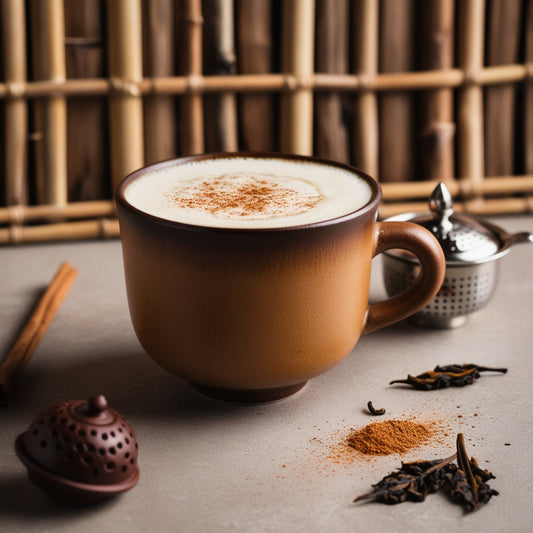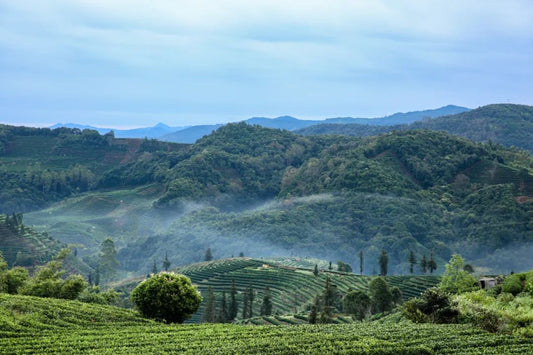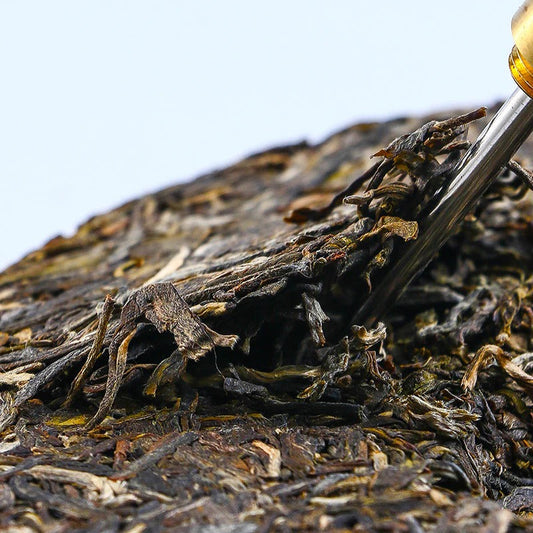Preview
Have you ever imagined a tea which ages like a fine wine? Well, that's the magic of Pu-erh tea - a one-of-a-kind beverage that transforms over time. All credit goes to the unique fermentation process.
In this guide we will discover the secrets of this ancient Chinese drink that has captivated tea lovers for centuries.
Moreover, we'll dig deep into the amazing fermentation journey that transforms ordinary tea leaves into the rich, earthy elixir known as Pu-erh. But that's not all – we'll also take you through the art of brewing this amazing tea, ensuring that you can feel its flavor and aroma. Get ready to become a true Pu-erh enthusiast!
Table Of Content
- Introduction
- The Fermentation Transformation of Pu-erh Tea
- Sheng vs Shou: The Two types of Pu-erh
- Verifying fermented Pu-erh tea
- The Art of Pu-erh tea prepration
- The Gongfu Brewing Tradition
- Conclusion
Introduction
Pu-erh tea is the only tea which goes through the unique fermentation process which can go for years. This process is completely natural and that is why is sets apart from other teas. Pu-erh tea has a long and storied history dating back centuries in the ancient Chinese province of Yunnan.
Pu-erh tea leaves undergo a remarkable transformation through fermentation, developing a rich, earthy, and complex flavor profile that has captivated tea enthusiasts worldwide and on the other hand regular teas that are simply dried and oxidized. This is why Pu-erh tea is expensive but it justifies every peny.

The Fermentation Transformation of Pu-erh Tea
Fermentation is a natural process that transforms fresh tea leaves into the distinctive Pu-erh tea. It involves the breakdown of organic compounds by microorganisms, primarily bacteria and fungi.
This transformation can be divided into three main stages:
Withering and Rolling:
In this workers wither the fresh tea leaves to remove moisture and make them pliable. Further, they roll the withered leaves to break down cell walls and initiate oxidation.
Pile Fermentation (Wo Dui):
After rolling, the leaves are piled and covered to undergo microbial fermentation. The pile is periodically turned and moistened to promote even fermentation. This stage can last from several months to several years, depending on the desired level of fermentation.
Pressing and Aging:
After achieving the desired level of fermentation, producers compress the leaves into various shapes, such as cakes or bricks. They then age these compressed forms for several years, allowing further fermentation and flavor development to occur. During aging, the tea continues to evolve, developing a richer, smoother, and more complex flavor profile.
That’s why the process take years. But once fermented it is worth to have.
Visit Pu-erh Craft as we have the best fermented tea.
Sheng vs Shou: The Two Types of Pu-erh
Pu-erh tea is basically differentiated into 2 types Sheng (raw) and Shou (ripe) This is because of the unique fermentation for the each type, but the end goal is the same – to create a rich, complex, and deeply satisfying tea.
Sheng: Sheng Pu-erh is made from fresh tea leaves that are allowed to ferment naturally over an extended period, often decades. This slow, natural fermentation process results in a tea with a bold, earthy, and sometimes slightly bitter flavor profile that mellows and becomes more complex with age.
Shou: Shou Pu-erh, on the other hand, undergoes a controlled fermentation process that accelerates the aging. This method, known as "wo dui," involves piling the tea leaves and exposing them to controlled humidity and temperature conditions, which kickstarts the fermentation process. The result is a Pu-erh tea that tastes remarkably similar to an aged sheng, but with a smoother, richer flavor profile that can be enjoyed sooner.
Verifying Fermented Pu-erh Tea
Look for these signs to determine if your Pu-erh tea is fermented:
1. Color: Fermented Pu-erh brews a dark reddish-brown or black color, while unfermented is lighter green-brown.
2. Aroma: Fermented Pu-erh has an earthy, musty, woody scent. Unfermented smells grassy or vegetal.
3. Flavor: Fermented Pu-erh tastes rich, deep, and earthy with notes of mushroom and sweetness. Unfermented is more astringent and grassy.
4. Leaves: Fermented leaves appear darker, compressed, and aged. Unfermented leaves are lighter and uniform in shape.
5. Labeling: Check product descriptions for terms like "fermented," "aged," "cooked," or "ripe" to indicate fermentation.
Experiencing the distinct characteristics of fermented Pu-erh tea firsthand is the best way to appreciate its unique flavors. If unsure, consult the seller.
The Art of Pu-erh Tea Preparation
Brewing Pu-erh tea is an art form in itself, and mastering the technique is essential to fully appreciate its unique flavors and aromas. Here's a step-by-step guide to help you brew the perfect cup of Pu-erh tea:
Step 1: Warm your brewing vessel (such as a gaiwan or a small teapot) by rinsing it with hot water. This helps prepare the vessel for the tea leaves.
Step 2: Measure out the desired amount of Pu-erh tea leaves and place them in the warmed brewing vessel. A general guideline is to use about 5-7 grams of tea leaves per 8 ounces (240 ml) of water.
Step 3: Give the tea leaves a quick rinse with hot water to "wake them up," then discard this rinse water.
Step 4: Pour fresh hot water over the tea leaves. The ideal water temperature for Pu-erh tea is usually between 195°F and 212°F (90°C and 100°C).
Step 5: Steep the Pu-erh tea for 30 seconds to 5 minutes, per your preference. Then carefully decant the steeped tea into a separate cup, leaving leaves behind.
Step 6: Slowly savor the rich, earthy aroma and flavor of the freshly brewed Pu-erh tea. Allow time for the flavors to fully develop on your palate.

The Gongfu Brewing Tradition
For true Pu-erh tea enthusiasts, the gongfu brewing method is a revered tradition that allows you to fully appreciate the nuances and complexity of this exceptional tea. Furthermore, This method involves using small brewing vessels, such as a gaiwan or a small teapot, and steeping the tea in multiple short infusions.
Here is a complete guide for gongfu brewing process:
- Warm your gaiwan or small teapot with hot water.
- Add a small amount of Pu-erh tea leaves, typically 5-7 grams.
- Rinse the tea leaves with hot water and discard the rinse water.
- Pour hot water over the tea leaves and steep for a short time, usually around 10-15 seconds for the first infusion.
- Decant the steeped tea into a fair cup or pitcher.
- Repeat the steeping process, gradually increasing the steeping time for each subsequent infusion (e.g., 15 seconds, 20 seconds, 25 seconds, etc.).
This method allows you to experience the subtle changes in flavor and aroma as you repeatedly infuse the tea leaves. With each steeping, the tea will reveal new layers of complexity, making it a truly immersive and meditative experience.
Exploring Its Health Benefits
In addition to its unique flavor profile, Pu-erh tea is also believed to offer several health benefits It's rich in antioxidants, which can help protect your body from harmful free radicals. Studies also suggest that Pu-erh tea helps in digestion, promote weight loss, and even have anti-aging properties.
But beyond its potential health benefits, Pu-erh tea is also a fascinating part of Chinese culture and history. Producers have passed down its production methods for generations, and enthusiasts often highly value and collect the tea itself.
Conclusion
Pu-erh tea is a true masterpiece that combines ancient traditions with a special fermentation process. This makes it a one-of-a-kind drink. The fermentation journey transforms regular tea leaves into a rich, earthy drink. Brewing and re-steeping Pu-erh tea allows you to explore many flavors and aromas.
Whether you love tea or are just starting, discovering our Pu-erh tea will be rewarding and enlightening. Embrace the art of fermentation, learn how to brew it properly, and let this extraordinary tea take you on a journey of pure enjoyment with every sip. Get ready to explore our collection for the magical experience of Pu-erh tea.
Q&A Section
1. What is the difference between the fermentation processes for sheng and shou Pu-erh teas?
A1. Sheng undergoes years of natural aging, while shou is piled and exposed to heat and humidity for accelerated fermentation over months, resulting in differing flavor profiles.
2. How does the gongfu brewing method differ from western brewing methods, and what are its benefits?
A2. Gongfu uses small vessels and multiple short steeps, gradually increasing times to extract layered flavors and aromas over many infusions, unlike Western methods that typically use a single longer steep.
3. What specific antioxidants are present in Pu-erh tea, and how do they benefit health?
A3. Pu-erh contains potent antioxidants like theabrines, thearubigins, and gallic acid with anti-inflammatory, anticancer, and cholesterol-lowering benefits from fermentation.
4. How does the fermentation process impact the caffeine levels in Pu-erh compared to other teas?
A4. Fermentation breaks down some caffeine, so Pu-erh tends to have lower caffeine levels compared to unfermented green or black teas from the same plant variety.
5. What water temperature and steeping times are recommended for optimal extraction of Pu-erh's flavors?
A5. For sheng, use 195°F-205°F water and 30 sec-1 min initial steep. For shou, 208°F-212°F water and 45 sec-2 min initial steep, adjusting later infusion times.






